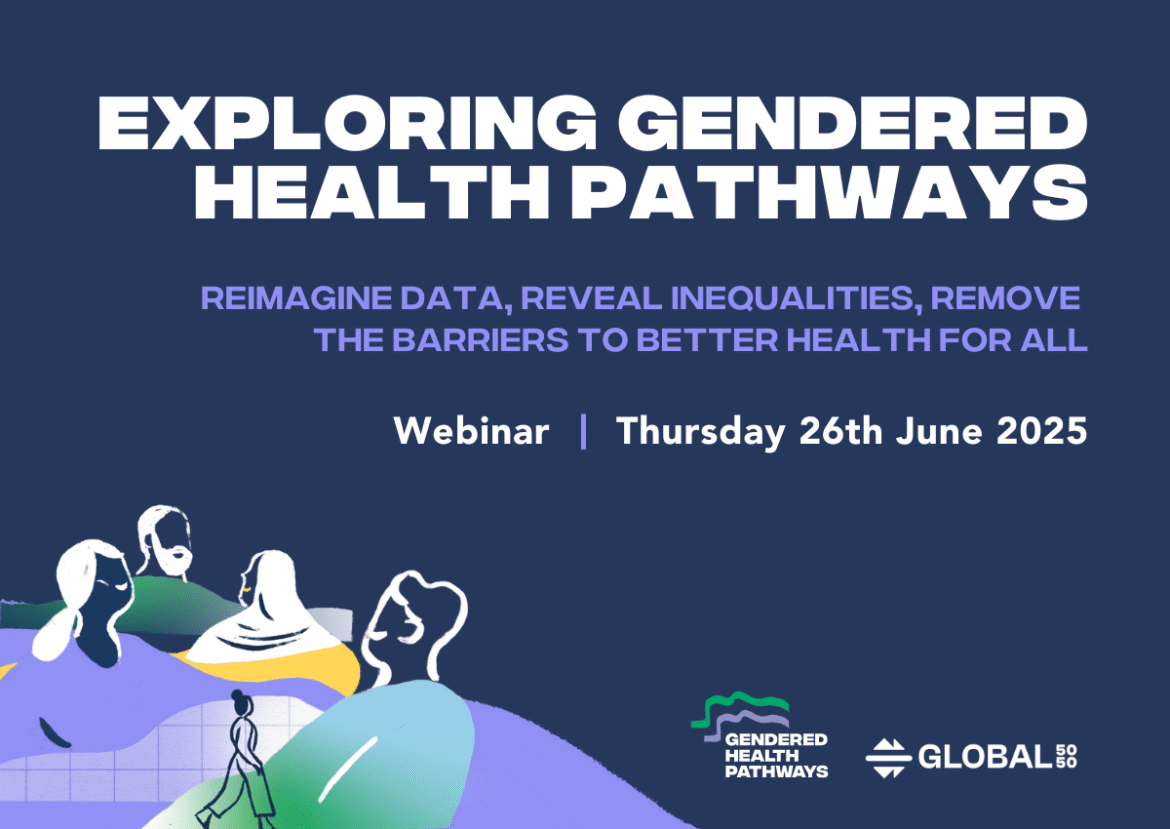Reimaging data in our ‘Exploring Gendered Health Pathways’ webinar
Find key insights and reflections from our online event and watch the recording below.
On 26 June 2025, we hosted the online launch of our new Gendered Health Pathways platform – a free to use, first-of-its-kind tool that maps how gender shapes men and women’s health journeys across three of the world’s deadliest conditions: diabetes, HIV, and hypertension.
The tool itself presents a clear and connected picture, stitching together datasets from WHO, UNAIDS, IHME and NCD Risk Factor Collaboration to visualise where, when, and how, men and women are being left behind across the care pathway, and revealing gendered disparities.
Explore the Gendered Health Pathways Tool
The event was moderated by Global 50/50’s Director of Programmes and Innovation Sonja Tanaka, and featured reflections and insights from:
- Prof Sarah Hawkes, Global 50/50 Co-CEO & Co-Founder and Head of the Department of Global Population Health at Monash University Malaysia
- Dr Angela Chang – Associate Professor, Danish Institute for Advanced Study; leading expert in global burden of disease and data modelling
- Julisa Tambunan – Deputy Executive Director, Equal Measures 2030; gender data advocate and feminist policy strategist
- Dr Swarup Sarkar – Senior Researcher; University of Gothenburg, Sweden; Ambassador, Global Health Security Network, Sydney, Australia; Ex CG Pandit National Chair, Indian Council of Medical Research and Ex Director / Senior Adviser WHO, UNAIDS, UNITAID, GFATM, ADB and CARE International
The webinar began with a short introduction by Prof Sarah Hawkes, who set the scene with the story behind our work, and highlighted why a tool like Gendered Health Pathways is so needed right now:
“We know that sex and gender influence health outcomes. We also know that we are living in a time when it’s becoming more and more challenging to talk about the role of gender as an influence on health outcomes.”
– Prof Sarah Hawkes
Dr Angela Y. Chang, a lead researcher on the project, then shared some key findings from the Gendered Health pathways data and the accompanying PLOS Medicine paper, including:
- Sex differences in exposure to risk factors such as smoking and obesity.
- Across all three diseases, men are less likely to be diagnosed, treated, or have their conditions controlled.
- Striking gaps in global data availability disaggregated by sex/age – even for high-prevalence, high-death rate conditions like tuberculosis.
The session continued with a live guided demonstration of the platform – showing how users can compare risk exposures, diagnosis, treatment and outcomes by sex, age, country and condition.
Then came reflections from the field in a live panel discussion and Q&A:
- Dr Swarup Sarkar focused on the systems-level uptake of gender data. He called the tool “a game-changer” but warned that even the strongest evidence will fall flat without political will, aligned funding priorities, and national accountability. Drawing on his experience in HIV policy, he stressed that tools must be used, not just created, and embedded into local, national, and donor-driven decision-making if they are to close equity gaps.
- Julisa Tambunan, by contrast, explored the legitimacy and protection of gender data in a time of political backlash. She argued that rigour and transparency in methodology are essential to defending gender data against distortion. But just as important, she noted, is storytelling, connecting data to real-world outcomes, centring lived experience, and building coalitions across sectors. In doing so, she reframed gender data not as ideological, but as foundational to achieving global development goals.
Watch the recording
Key links
PLOS Medicine Article: Sex-disaggregated data along the gendered health pathways
Dr Angela Y. Chang’s presentation of the tool’s key findings was grounded in the recently published PLOS Medicine article. She explained that the paper provides a more detailed, global analysis of the data presented in the tool, exploring patterns across regions, age groups, and the full health pathway for diabetes, HIV and hypertension. While the tool offers country-level visualisations, the article dives into the aggregated trends and presents hypotheses about why certain disparities appear in specific contexts. Angela noted that the paper and the tool are complementary: “The tool allows you to look quite quickly and visually… whereas the paper itself talks about the global aspect… and why we think certain things are happening in different parts of the world.”
The Lancet Commission on Gender and Global Health
In her opening remarks, Prof Sarah Hawkes drew on the conceptual foundation laid out in the Lancet Commission on Gender and Global Health, which she co-chaired. She framed gender not as a proxy for biological difference, but as “the unequal distribution of power and privilege” that interacts with other social determinants to shape people’s health. Sarah explained that this understanding is central to Global 50/50’s work and to the design of the Gendered Health Pathways tool, because it allows us to examine not just whether differences exist, but why they do, and where targeted interventions can address them. This framing, and the challenges of talking about gender in today’s political climate, are explored in greater depth in the Commission’s report.
Want more like this?
Sign up for our newsletter to receive updates on Gendered Health Pathways and other initiatives from Global 50/50.
Sign up now
This is only the beginning. Let’s work together to build evidence, shift systems, and make health equity a reality for all.


